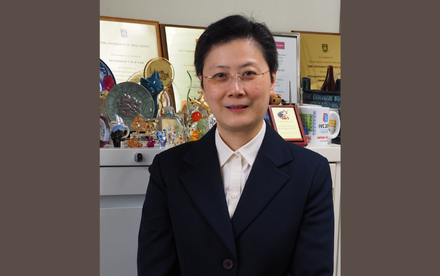11 Feb 2019
HKU chemists develop a new class of robust gold(III) complexes with promising device lifetimes and tunable emission colours for vacuum-deposited OLEDs
Professor Vivian Wing-Wah Yam (middle) and her research team
A team of researchers led by Professor Vivian Wing-Wah Yam, Philip Wong Wilson Wong Professor in Chemistry and Energy and Chair Professor of the Department of Chemistry, has overcome the key synthetic challenges for the design of robust gold(III) complexes and demonstrated for the first time highly efficient gold(III)-based organic light-emitting devices (OLEDs) with long operational lifetimes, reaching half-lifetimes of up to 83,000 hours. The findings have been published in January in the leading scientific journal, Nature Photonics (link).
Gold, a noble metal that has been widely used as currency and ornamental jewellery since ancient times and more recently in industry, has been a metal well-known for its inertness, low toxicity, and environmentally friendly and benign nature. With China having the second largest gold reserve in the world, there is a strong motivation and advantage of developing the organometallic chemistry and novel materials of gold, such as phosphorescent emitters for OLEDs. Through dedicated efforts and rational design of pincer and ancillary ligands, the team has found the right balance for the ligand coordination environment to overcome the thermal stability challenge, generating a new class of robust gold(III) complexes with tridentate C^C^N ligands. This class of gold(III) complexes demonstrates full-colour gamut spanning across the visible region from sky-blue to red with high solid-state photoluminescence quantum yields of up to 80%. These complexes are also capable of serving as phosphorescent dopants for OLEDs; notably, extraordinarily high current efficiencies of up to 72 cd A-1 and external quantum efficiencies of up to 21.6% have been achieved. More importantly, long device half-lifetimes of up to 83,000 hours have been realised in these gold(III)-based OLEDs. This is the first practical gold(III)-based OLEDs with long device lifetime. The present work holds great promise and would open up a new avenue for the development of new classes of practical phosphorescent emitters based on metal centres other than the commercially used but rare iridium(III) system, paving the way towards the possible revolutionisation of the OLED market.


 More information about Professor Vivian Yam.
More information about Professor Vivian Yam. 




